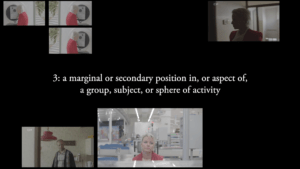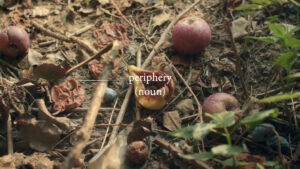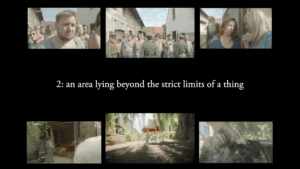Thus far, the TV Dictionary project has gathered an impressive number of 80 short video essays. Seeing these videographic works from the perspective of East-Central European scholars and television aficionados, what catches our attention (besides their aesthetic quality and theoretical/historical insight) is one tiny little thing. Almost all the presented entries cover TV shows that were produced within the Anglo-American context. Sure, there are a few exceptions, yet those come from other centers of the global television industry, such as Germany, Italy, Japan, and Denmark. This fact is quite logical considering that the majority of active videographic scholars come from the Western center, but still…
It seems that our entry on the Czech TV miniseries Vodník is the only one produced within the context of a periphery (or a semi-periphery, to be precise).[1] Under these terms, the aim of our short video essay was quite prophetic as it addressed precisely the place of local TV series (albeit with quality TV ambitions) within production and reception fields which lean towards the global center. The question that arose was: how to make a peripheral TV series accessible to the global center without using colonizing or orientalizing rhetoric? In other words, how to describe a TV production created on the margins of the global audiovisual industry without tailoring it to the expectations of the Western audience and reducing its local specificity to an abstract concept or a mere gimmick, to just another example, another illustration, another piece of data?
Our case study was Vodník (The Water Goblin, 2019), a Czech television miniseries directed by Viktor Tauš. Its story is inspired by a 19th-century ballad of the same name, based on Slavic folklore, in this case, the myths of lakes, rivers, and ponds. The series situates these folkloric themes within the rules of detective fiction and, at the same time, the memories of the late 1980s Czechoslovak countryside. Its plot, concerning a murder of a newborn baby by an unknown and mythical entity (the water goblin), is told partly in flashback, portraying the past as a blurred memory in which reality blends with fantasy. The scenes from the past employ visual iconography and historical sensibility associated with late socialism in Eastern Europe, while the current reality is framed through the lens of Eastern European capitalist realism. The series suggests continuities rather than discontinuities between the past and the present, highlighting rampant corruption, dissolution of family bonds, and the individualistic attitude of the characters. Despite the cruelty, the folklore motifs offer glimpses of utopia and hope of transcending the overwhelming depression of communist and post-communist everyday reality.
Thus, Vodník infuses the global formulas of quality TV crime fiction with elements that are distinctively local, both concerning past and present reality and the world of myth and fantasy. Still, as the previous paragraph testifies, describing these features in a form that is accurate, accessible, and specific enough within a limited space is an ungrateful task. In our heads, all that we wrote about the series’ depiction of the late socialist past, capitalist realist present, Slavic folklore, and mythical water creatures feels somewhat simplistic – reducible to general tropes and illustrations that confirm the existing assumptions and prejudices of the global center rather than disprove them.
The videographic TV Dictionary format proved fruitful for indicating how such a problem could be addressed. Instead of trying to come up with elaborate language to conceptualize what makes Vodník locally unique yet globally appealing, we chose a simple dictionary entry that articulates both the series’ place within global audiovisual production AND its locally specific themes:
Periphery (noun)
1: the outer limit or edge of an area or object
2: an area lying beyond the strict limits of a thing
3: a marginal or secondary position in, or aspect of, a group, subject, or sphere of activity
Perhaps most importantly, our video essay grasps this principle literally and materially, as a way of organizing the scenes. Each of the definitions leads to a disintegration of the image into a multitude of parallel windows on the periphery of the frame. In doing so, our call for taking peripheral TV series seriously addresses the viewers on the level of content as well as on the level of form. While our video essay certainly does not resolve the existing hierarchies between center and periphery, we hope that it will provoke scholars, artists, and general viewers to pay more attention to peripheral TV productions and the ways in which they combine the globally comprehensible and the locally specific.
We recommend checking out David Martin-Jones’s entry on Battle of the Planets. The essay showcases how many forms a single TV series can acquire across various languages and cultural contexts.
Jiří Anger is a researcher and lecturer at the Department of Film Studies, Charles University in Prague. He also works at the National Film Archive in Prague as a researcher and editor of the peer-reviewed academic journal Iluminace. He specializes in the theory and history of early cinema, archival film, found footage, and videographic criticism. Anger’s texts and videos have appeared in journals such as NECSUS, Film-Philosophy, or [in]Transition. For the article “Trembling Meaning: Camera Instability and Gilbert Simondon’s Transduction in Czech Archival Film,” he won the Film-Philosophy Annual Article Award 2022.
Facebook: https://facebook.com/jiri.anger | Instagram: https://instagram.com/found_footage_kfs/ | Academia.edu: https://cuni.academia.edu/JiriAnger
Veronika Hanáková recently graduated with a master’s degree in new media studies from the Faculty of Arts, Charles University in Prague. Her research focuses on the materiality and preservation of digital images, including those deemed unpreservable. Together with Jiří Anger, they curate the audiovisual essay section at the Marienbad Film Festival.
Facebook: https://facebook.com/veronikahxp | Instagram: https://instagram.com/plastovy_narcis/ | Academia.edu: https://cuni.academia.edu/VeronikaHanakova
Footnote
[1] Dorothee Bohle and Béla Greskovits, Capitalist Diversity on Europe’s Periphery (Ithaca and London: Cornell University Press, 2012), 44-48.









